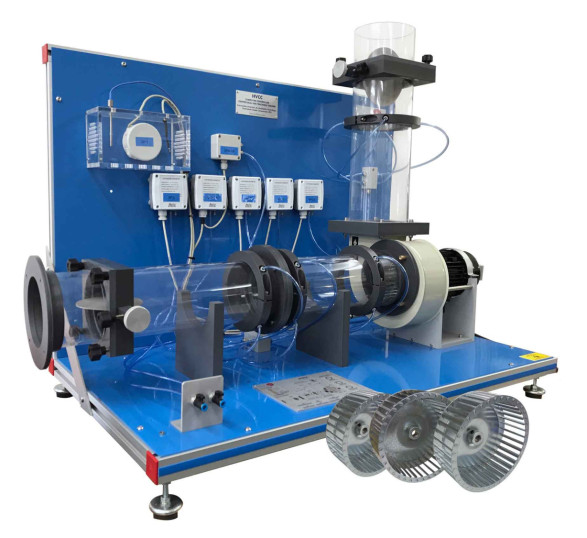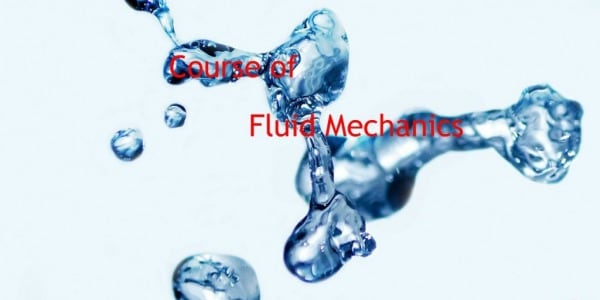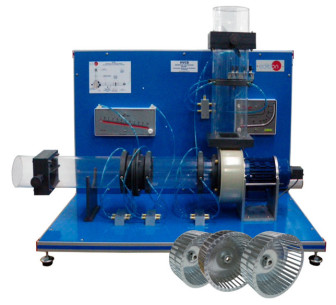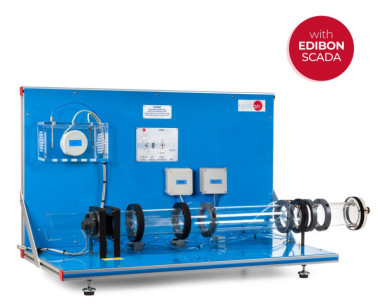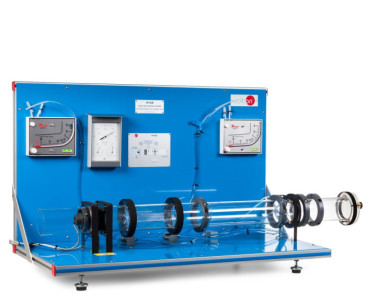HVCC Didaktisches Gerät für einen Zentrifugalventilator, computergesteuert (PC)
INNOVATIVE SYSTEME
The Computer Controlled Centrifugal Fan Teaching Unit, "HVCC", allows the students to study the operation characteristics of a centrifugal fan.
Erweiterungen
Laboratorien
ÄHNLICHE NEUIGKEITEN
ALLGEMEINE BESCHREIBUNG
The Computer Controlled Centrifugal Fan Teaching Unit, "HVCC", allows the students to study the operation characteristics of a centrifugal fan. For that purpose, the unit carries out the measurements of flow, speed, temperature, pressure and humidity. Multiple tests related to air flows can be performed with the accessories.
The main element of this unit is a computer controlled speed centrifugal fan, which is measured through a speed sensor, and a wattmeter determines the power consumed by the fan.
The unit also includes an aspiration duct and a discharge duct, both transparent. Two butterfly valves, placed in the inlet of the aspiration duct and at the outlet of the discharge duct, regulate the air flow.
The transparent aspiration duct has an orifice plate to calculate the air flow through a differential pressure sensor.
There are other two differential pressure sensors to measure the pressure in the aspiration duct and in the discharge duct.
The unit is supplied with a set of three interchangeable turbines to study and analyse the influence of the blades shape:
- With the blades curved forwards.
- With the blades curved backwards.
- With perpendicular blades.
There are also temperature, pressure and humidity measurements to know the inlet air conditions.
This Computer Controlled Unit is supplied with the EDIBON Computer Control System (SCADA), and includes: The unit itself + a Control Interface Box + a Data Acquisition Board + Computer Control, Data Acquisition and Data Management Software Packages, for controlling the process and all parameters involved in the process.
ÜBUNGEN UND GEFÜHRTE PRAKTIKEN
GEFÜHRTE PRAKTISCHE ÜBUNGEN IM HANDBUCH ENTHALTEN
- Calculation of the flow with the orifice plate.
- Calculation of the typical curve of a fan at a constant turning speed (turbine with blades curved forwards).
- Calculation of the typical curve of a fan at a constant turning speed (turbine with blades curved backward).
- Calculation of the typical curve of a fan at a constant turning speed (turbine with perpendicular blades).
- Study of the dependency on the type of turbine. Comparison of the results of the different types of blades.
- Calculation of the efficiency of the fan.
- Introduction to affinity laws for fans.
- Study of the static pressure increase.
- Sensors calibration.
MEHR PRAKTISCHE ÜBUNGEN FÜR DAS GERÄT
Additional practical possibilities:
- Measurement of performance at constant speeds.
- Study and comparison of the practical results and the results calculated by the students.
Additional practical possibilities (Additional recommended elements):
- Measurement of the static pressure in a duct with one or two static pressure takings (HVCC-C1TP or HVCC-C2TP accessories).
- Measurement of the flow in a duct with one pressure taking with Pitot (HVCC-CTPP and HVCC-CTPG accessory).
- Study of the influence of straighteners (HVCC-EFCG, HVCC-EFCP and HVCC-EFS accessories).
- Study of the influence of a symmetrical shutter (HVCC-OS accessory).
- Measurement of the flow in a duct with a nozzle (HVCC-T2D accessory).
- Measure of the pressure distribution around a cylinder subjected to transverse incident flow (HVCC-CDP accessory).
- Measure of the pressure losses in different pipe elements (HVCC-TA accessory).
- Study of the effect of differently shaped pipe inlets (HVCC-TA accessory).
- Study of a cooling curve (HVCC-TC accessory).
- Determination of the heat transfer coefficients from the cooling curve (HVCC-TC accessory).
Additional practical possibilities (Optional Models and Accessories):
- Measurement of the total pressure in the wake of a cylinder (HVCC-CDP and HVCC-CTPG accessories).
- Determination of the drag coefficient from the pressure distribution in the wake of a cylinder (HVCC-CDP and HVCC-CTPG accessories).
- Demonstration of the wake depression (HVCC-CDP and HVCC-CTPG accessories).
Other possibilities to be done with this Unit:
- Many students view results simultaneously. To view all results in real time in the classroom by means of a projector or an electronic whiteboard.
- Open Control, Multicontrol and Real Time Control. This unit allows intrinsically and/or extrinsically to change the span, gains, proportional, integral, derivative parameters, etc, in real time.
- The Computer Control System with SCADA and PID Control allow a real industrial simulation.
- This unit is totally safe as uses mechanical, electrical and electronic, and software safety devices.
- This unit can be used for doing applied research.
- This unit can be used for giving training courses to Industries even to other Technical Education Institutions.
- Control of the HVCC unit process through the control interface box without the computer.
- Visualization of all the sensors values used in the HVCC unit process.
- By using PLC-PI additional 19 more exercises can be done.
- Several other exercises can be done and designed by the user.
ÄHNLICHE VERFÜGBARE GERÄTE
ERGÄNZENDE AUSRÜSTUNG
Didaktisches Gerät für einen Zentrifugalventilator
Didaktisches Gerät für einen Axialventilator, computergesteuert (PC)
Didaktisches Gerät für einen Axialventilator
QUALITÄT

KUNDENDIENST

 Cookie-Präferenzen
Cookie-Präferenzen

